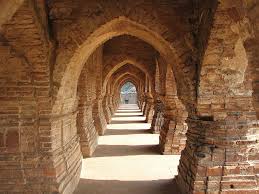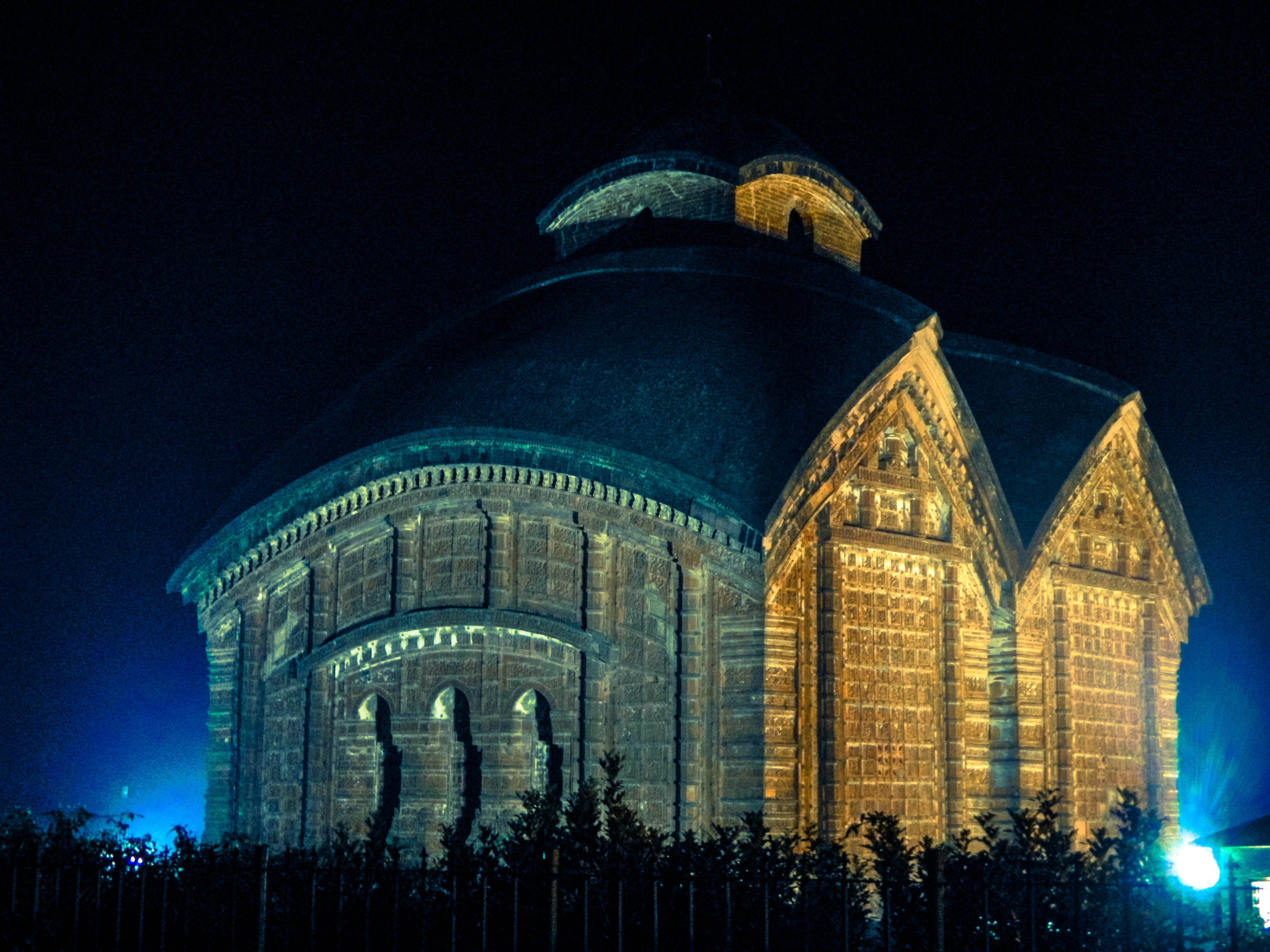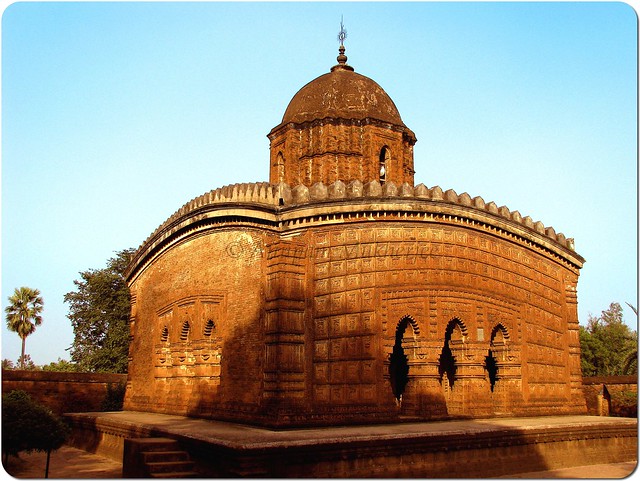Bishnupur is located in the Bankura district of the state of West Bengal.Bishnupur is incredibly famous for the magnificent Terracotta temples and the beautiful Baluchari saris. The town has a glorious past that is reflected in its rich architecture, music and handicrafts such as pottery and weaving. It prospered in the 17th and early 18th Centuries. Ruled by a line of Hindu Rajas of the Malla dynasty, Bishnupur developed a unique form of architecture and has perhaps the most brilliant and detailed terracotta work in Eastern India that has withstood the ravages of time.The history of Bishnupur can be dated back to 694 AD, when King Raghunath I established Malla dynasty. But the place got its name as Bishnupur much later in 994 AD. It is derived from the name of the Hindu God “Vishnu”.The Mallas solemnized their love for Lord Krishna by building these beautiful temples.
How to reach here:
By Air: The nearest airport is at Netaji Subhash Chandra Bose Intl Airport, Kolkata (CCU), around 145 km, and is well connected to various national as well as international cities.
By Rail: Bishnupur has a railway station which is connected to the major parts of the city.
Best time to visit: October to March.
Languages spoken: Bengali, Hindi.
Places you must visit:
Rasmancha is the oldest brick temple in Bishnupur. Built by Malla King Bir Hambir in 1600 CE, the temple has only one chamber, the sanctum sanctorum, with an elongated tower encircled by turrets which are of hut shapes. It is enclosed by a passageway and there are some big cannons which date back to Malla period. It has a unique structure and is the only temple of its kind in India.The Rasmancha was built in a way to accommodate the deities that people brought during the festivals. This structure is showcased nowadays by illuminating at night.



The Jorebangla temple in brick was built by the Malla King Raghunath Singh in 1655.The structure was erected on one metre high platform using laterite bricks. The entire outer surface is decorated with terracotta plaques displaying various aspects of human life and culture, gods and goddesses, animals, floral and geometrical designs.Some of the carved designs of the Royal lifestyles, stories depicting the epics, historical scenes from the battles, etc are found on the walls and on the roof of the temple.




The beautiful terracotta Panch Ratna temple was constructed by King Raghunath Singha in 1643 AD. Shyam Rai Temple has the most intricate sculptural details amongst all the Bishnupur temples.


The temple of Madan Mohan was built outside the fort compound by King Durjana Singh Dev, in 1694 AD for his family deities of Lord Krishna and Radha. There are impressive scenes from the Ramayana, Mahabharata and the Puranas carved on the temple walls. The temple is the best example in brick of Ratha or chariot style architecture with a single sikhara(tower) and a curve Bengali chala type roof.



This laterite Lalji Temple was built in 1658 by Bir Singha II of Malla dynasty.The deity worshipped here are Sri Krishna and Radhika. The temple is constructed on a square raised plinth, which consists of ornamental stucco decorations on low relief carvings.

The Acharya Jogesh Chandra Purakriti Bhawan in Bishnupur is a museum that relate to art and archeology.In this archeological gallery there are tools from Mesolithic and Paleolithic era, metal ornaments, terracotta sculptures, etc. This Museum accounts for the coins and artifacts from the very ancient days of rulers in Bishnupur, starting from the gupta kings to the pal kingdom.There are contemporary art and paintings, manuscripts and rare photographs. A section of the Purakriti Bhawan is dedicated to the musical culture of Bishnupur Gharana and has many instruments and photographs displayed.



The Sridhara temple was built in the 19th century and is known for the nine spires, known as the navaratna.Beautiful carvings adorn the walls of the temple. Lord Shiva in a dancing pose present at the entrance of the temple shows the heritage of Bengal and the importance given to the architecture by the kings of Bishnupur.


The cannon named as Dal Madol was built by the Malla kings to fight the Maratha invasion. This Cannon is near Chinnamasta temple and is significant for the people of Bishnupur as well as Bengal. The cannon measures about 3.8 m in length and has a barrel of 28.5 cms. It was built in the year 1742 under Raja Gopal Singh to protect Bishnupur from Marathas. The Cannon is built with iron materials and doesn’t have any rust, though it is exposed to rain and sun since 18th century.

How to reach here:
By Air: The nearest airport is at Netaji Subhash Chandra Bose Intl Airport, Kolkata (CCU), around 145 km, and is well connected to various national as well as international cities.
By Rail: Bishnupur has a railway station which is connected to the major parts of the city.
Best time to visit: October to March.
Languages spoken: Bengali, Hindi.
Places you must visit:
Rasmancha is the oldest brick temple in Bishnupur. Built by Malla King Bir Hambir in 1600 CE, the temple has only one chamber, the sanctum sanctorum, with an elongated tower encircled by turrets which are of hut shapes. It is enclosed by a passageway and there are some big cannons which date back to Malla period. It has a unique structure and is the only temple of its kind in India.The Rasmancha was built in a way to accommodate the deities that people brought during the festivals. This structure is showcased nowadays by illuminating at night.
The Jorebangla temple in brick was built by the Malla King Raghunath Singh in 1655.The structure was erected on one metre high platform using laterite bricks. The entire outer surface is decorated with terracotta plaques displaying various aspects of human life and culture, gods and goddesses, animals, floral and geometrical designs.Some of the carved designs of the Royal lifestyles, stories depicting the epics, historical scenes from the battles, etc are found on the walls and on the roof of the temple.



The beautiful terracotta Panch Ratna temple was constructed by King Raghunath Singha in 1643 AD. Shyam Rai Temple has the most intricate sculptural details amongst all the Bishnupur temples.

The temple of Madan Mohan was built outside the fort compound by King Durjana Singh Dev, in 1694 AD for his family deities of Lord Krishna and Radha. There are impressive scenes from the Ramayana, Mahabharata and the Puranas carved on the temple walls. The temple is the best example in brick of Ratha or chariot style architecture with a single sikhara(tower) and a curve Bengali chala type roof.



This laterite Lalji Temple was built in 1658 by Bir Singha II of Malla dynasty.The deity worshipped here are Sri Krishna and Radhika. The temple is constructed on a square raised plinth, which consists of ornamental stucco decorations on low relief carvings.
The Acharya Jogesh Chandra Purakriti Bhawan in Bishnupur is a museum that relate to art and archeology.In this archeological gallery there are tools from Mesolithic and Paleolithic era, metal ornaments, terracotta sculptures, etc. This Museum accounts for the coins and artifacts from the very ancient days of rulers in Bishnupur, starting from the gupta kings to the pal kingdom.There are contemporary art and paintings, manuscripts and rare photographs. A section of the Purakriti Bhawan is dedicated to the musical culture of Bishnupur Gharana and has many instruments and photographs displayed.
The Sridhara temple was built in the 19th century and is known for the nine spires, known as the navaratna.Beautiful carvings adorn the walls of the temple. Lord Shiva in a dancing pose present at the entrance of the temple shows the heritage of Bengal and the importance given to the architecture by the kings of Bishnupur.
The cannon named as Dal Madol was built by the Malla kings to fight the Maratha invasion. This Cannon is near Chinnamasta temple and is significant for the people of Bishnupur as well as Bengal. The cannon measures about 3.8 m in length and has a barrel of 28.5 cms. It was built in the year 1742 under Raja Gopal Singh to protect Bishnupur from Marathas. The Cannon is built with iron materials and doesn’t have any rust, though it is exposed to rain and sun since 18th century.

No comments:
Post a Comment